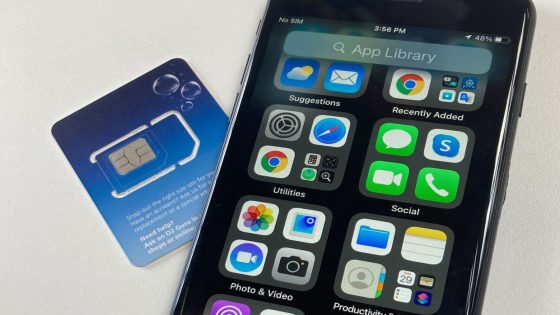LONDON: For summer trips overseas, a smartphone is essential for most people. How else will you check Google Maps to find your Airbnb, post an Instagram video from the Eiffel Tower, or WhatsApp friends and family back home?
Of course, if you’re using apps that gobble up data while travelling in a foreign country, there’s always a risk of racking up hefty roaming fees from your phone carrier. The solution? An international travel eSIM for your smartphone.
How do you use this technology? Here are some tips.
What’s an eSIM?
If you’ve ever bought a new cellphone, you’re probably familiar with the SIM card. Short for subscriber identity module, the SIM is a little chip the size of a fingernail that fits into a slot on most phones. Without it, you couldn’t get cell service because it contains your account information and phone number.
But physical SIM cards are slowly being replaced by eSIMs – the ‘e’ stands for embedded – built into newer phones. These digital versions do the same thing and can make life easier, though people used to physical SIMs might find them confusing at first.
Why should I use an eSIM?
They make switching cell carriers easier. And if you’ve bought a new phone recently, you might not even have a choice: Apple got rid of the SIM card tray starting with the iPhone 14 released in September 2022.
They’re especially beneficial for travellers. If you’ve got a compatible cellphone, you can add an eSIM from a virtual carrier that has better data roaming rates than your home network. Many phones will allow you to add more than one eSIM, making it easy to switch back and forth, or – for phones with the capability – use two at the same time.
Think of the convenience: Gone are the days of arriving in a strange country after a long flight, looking for a local phone company’s airport kiosk, carefully popping open the SIM tray with a pin to swap in the new chip, and trying not to lose the existing one.
Where do I get a roaming eSIM and how much will I pay?
The eSIM market is booming. Kester Mann, director of consumer research at CCS Insight, says there are dozens of providers that can be found online, with names like Nomad, Holafly, Easysim, Airhub and Airalo.
“These guys have a role to play because I think they offer a very affordable and attractive opportunity for international travelers,” Mann said.
The boom means there’s plenty of competition keeping rates low. Prices are typically clearly displayed online, either through a menu of packages on the provider’s website or a calculator based on the amount of data needed and trip length.
Some 800 carriers support eSIMs, according to CCS, so international coverage is extensive. Many eSIM providers offer packages based on country or region, so you can check which ones have good rates for the place you’ll be visiting and sign up in advance. Travelling to Europe and need data for a month covering 30 countries? Airalo offers, for example, 10 gigabytes at US$37 (RM174) while Holafly’s package has unlimited data for €69 (RM353).
For an upcoming trip to Prague, I bought 5 gigabytes of data for just US$5 (RM23) from Global Yo. I was slightly put off by some negative reviews professing problems buying, installing or activating the company’s eSIMs, but I didn’t have any problems myself.
How do I put an eSIM on my phone?
You’ll need a phone that’s unlocked for use with different wireless carriers.
If you’re not setting up a new phone, the typical activation method is with a QR code, or a more conventional string of numbers and letters. If you’re planning a trip and buy one before you leave, it’s a good idea to print out the code if you don’t want to activate right away.
For iPhones, go to your Settings menu, then to either the Cellular or Mobile Service section, then tap Add eSIM. You’ll be prompted to scan the code, or manually enter it. The process is similar for Android users. Samsung has a guide for Galaxy devices, and Google has a help page for Pixel users, while eSIM carriers have step-by-step instructions. Apple has a YouTube video, as well as tip sheets on using eSIMs for international travel and on using two eSIMs simultaneously.
If you’ve got a phone that supports dual eSIMs, you “can pick potentially the best network based on price and or coverage” while traveling, said Mann.
Some carriers have their own apps to manage eSIMs and track data usage.
How do I know if my cellphone can use an eSIM?
More than 200 devices support the technology, CCS Insight says. UK phone company Vodafone has a list of compatible devices. Or dial (asterisk)#06# – an EID code indicates it’s compatible.
For iPhone users, it’s any model released since the XS, XS Max or XR, as well as recent iPads. They’re compatible with any Samsung Galaxy devices released since 2020, and Google Pixel 4 and newer models will work; some Pixel 3 devices also support them.
Does it always make sense to use a travel eSIM?
First check your own carrier’s roaming costs for the places you’re visiting. Sometimes it’s not worth it.
“Roaming costs these days are far lower and less prohibitive than they once were,” said Mann. They’ve even been abolished for European Union residents crossing the 27-nation bloc’s internal borders. But travellers in Britain, which has left the EU, are facing them again for travel to the continent. – AP
Source Agencies



